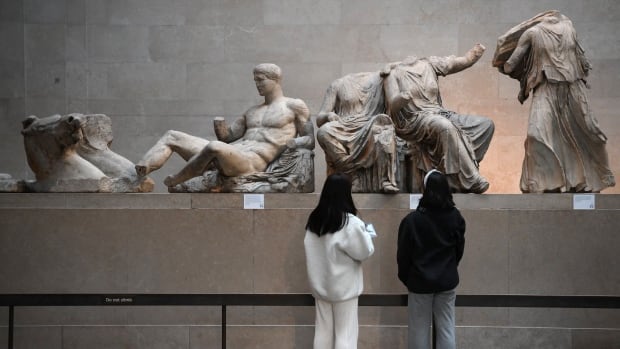Greece’s government on Tuesday accused Britain of showing “a lack of respect” by abruptly cancelling a meeting between their leaders at short notice in a dispute over 2,500-year-old Parthenon sculptures brought to Britain in the 19th century.
British Prime Minister Rishi Sunak cancelled a planned wide-ranging meeting with his Greek counterpart Kyriakos Mitsotakis after the latter raised the decades-old demand for the return of the sculptures from the British Museum.
“It shows a lack of respect to the prime minister but also to the country he represents,” said Pavlos Marinakis, a spokesperson for the Greek government.
Sunak’s decision to cancel the meeting was also criticized by some British opposition parties and a campaign group backed by British politicians from different parties who want to resolve the issue.
That group, the Parthenon Project, has proposed a deal that would see the sculptures reunified in Athens — without Britain and Greece needing to agree on who owns them.
“I don’t think the prime minister needed really to intervene in this way and it hasn’t particularly helped our relationships with Greece,” said Ed Vaizey, a former Conservative culture minister who advises the Parthenon Project.
Appearing on the BBC over the weekend, Mitsotakis compared the separation of the sculptures to cutting the Mona Lisa in half, a characterization rejected by British government.
Here’s more on the history of the dispute:
What are the sculptures?
The largest temple on the Acropolis, the Parthenon has operated as an archaeological site since 1833, surviving wars and natural disasters to become the symbol of modern Greece.
The sculptures at the British Museum make up about half of a 160-metre frieze that adorned the Parthenon temple on the rocky Acropolis hill in Athens. The collection includes 15 sculpted relief panels and figures of gods and heroes from the temple’s pediments.
They are original parts of the temple dedicated to the goddess Athena, completed in 432 BC as the crowning glory of Athens’ Golden Age.
LISTEN l From October 2021:
Stuff The British Stole36:46S2 E2: Losing Your Marbles
Featured VideoThey’ve seen wars, the bottom of the ocean and even — bizarrely — been part of a boxing match. The story of how the Parthenon Marbles actually ended up in London’s British Museum is a wild tale featuring bribes, court cases and some extremely dodgy deals. There’s been a centuries-long campaign to get them back to their homeland. Now, a team of Greek-Australians have decided that the time for diplomacy is over and a new tactic is required. For transcripts of this series, please visit: https://www.cbc.ca/radio/podcastnews/stuff-the-british-stole-transcripts-listen-1.6804375
Why are they in Britain?
The sculptures, known as the Elgin Marbles in Britain, include part of a frieze, relief panels and other figures that were removed from the Parthenon in the early 19th century by Thomas Bruce, the 7th Earl of Elgin and then-British ambassador to the Ottoman empire.
They were transported to Britain and bought by the British Museum in 1816 and are exhibited as a prized part of its collection in London.
Since the late 1930s they’ve been housed at the museum in the Duveen Gallery, named after art dealer Sir Joseph Duveen.
LISTEN l From August 2022:
Day 68:15A high-tech proposal for returning the famed Elgin Marbles to Greece
Featured VideoA digital archaeologist is using robots to make replicas of the Parthenon Sculptures in hopes the British Museum will decide to display them and return the originals to Greece. The museum says it will allow the sculptures to be temporarily displayed elsewhere but they must be returned.
Greece’s stance

While Athens has called for the permanent return of the treasures since its independence from the Ottoman Empire in 1832 and accused Elgin of theft, the campaign garnered more attention in the 1980s.
Greek Oscar-nominated actress Melina Mercouri, a vocal supporter of the arts, launched an official campaign for their return when she was culture minister in 1981-1989.
Athens has further stepped up its efforts since it opened a museum in 2009 at the foot of the Acropolis, which holds the sculptures that remain in Greece. With a view of the Parthenon, the layout of the top floor of the museum mimics the temple.
In September 2019, Mitsotakis suggested Athens would be willing to loan antiquities to the British Museum in return for being able to temporarily exhibit them. Greece said the proposal did not alter its long-standing demand for their permanent return.
The British Museum position

The British Museum, custodian of the sculptures, has refused to return them, saying they were acquired by Elgin under a legal contract with the Ottoman Empire that then ruled Greece.
The trustees of the museum say the public would benefit more from having the sculptures divided between two museums, that bringing them back together into a unified whole is impossible as some parts were lost or destroyed, and that the sculptures could not be safely returned.
The trustees have said they would consider a loan to Greece if Greece acknowledges the British Museum’s ownership of the sculptures, which Greek governments have refused in the past.
Such disputes are not unprecedented
In January 2022, a museum in Italy loaned Athens the so-called “Fagan” fragment, depicting the foot of the ancient Greek goddess Artemis. It later said the fragment — part of the temple’s eastern frieze — could stay in Greece.
Earlier this year, the Vatican returned to Greece three pieces of the Parthenon that had been in the papal collections of the Vatican Museums for more than a century.
The British Museum also houses, among other artifacts, two large stone moai statues — Hoa Hakananai’a and Moai Hava — taken by British ship in the 19th century from Easter Island, also known as Rapa Nui. Chile, which later annexed Easter Island in the Pacific, has requested their return.


